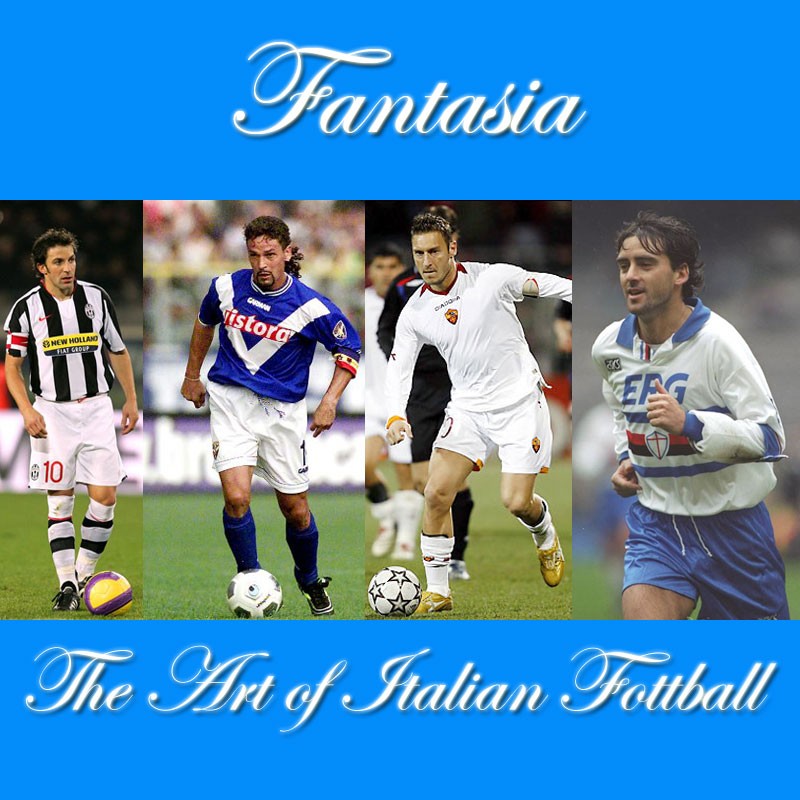The ball is caressed, tamed, hit according to laws – which, despite being spontaneous, obey a sublime, abstract, fantastic geometry whose form expresses the best intentions of a man: generosity, a sense of togetherness, of altruism, of friendship, of courage, of trust, of hope, of gullibility, of fantasy, of shrewdness, of faked naivety, of timing, of ferocity, of open-mindedness… –Gianni Brera
In these lines, Gianni Brera, an Italian sports journalist describes his understanding of Italian football. It won’t be a hyperbole when you hear someone say that the game of football, in a nation that gave our world “The Renaissance”, is an art and not merely a sport. Italian football can be defined as an enthralling mixture of the artistic, the extravagant and the Machiavellian. Football in Italy, a nation where the largest selling daily newspaper is dedicated almost entirely to football; where its former ruling party is named after a football chant; and where its Prime Minister owns one of the world’s most famous and successful clubs; is treated as an entity, which the people can relate to. It is as seductive as Aphrodite, as elegant as Mona Lisa’s smile and as ruthless as a storm.
The art of playing the game is entirely different in Italy when compared to other countries; it is stylish and cunning at the same time and these art forms in the game are known as Fantasia and Furbizia; the two ingredients of Italian football that make it exquisite.
Fantasia is the art of producing that magical moment which leaves the opponent spellbound, one time frame of surprise which can split a defense enough for a fantasisti to leave the defender mesmerized. It can be a back heel, a dummy move, a dissimulation of being weary and lots of other creative moves. All of these are instinctive and a moment of sudden inspiration. Italians are the masters of this art. One may argue by comparing it with the “Jogo” of South American football giants Brazil, but it is different.
–
The way Brazilians play, can be related to their spirit of celebrations and it’s more like a dance form in terms of artistry. They will orchestrate the move so that it appears so beautiful that a defender can only rape it with brute force and not with elegance. Fantasia, on the other hand, is more of a surprise. Jogo and Fantasia should not be confused with each other.
The two may appear synonymous, but the difference can be explained from a defender’s perspective: a defender will admire the Jogo and lose the focus while admiring the artistry whereas a fantasisti will wait for the defender to be low on focus and produce a a split-second trick to take advantage of the low focus of a defender. Fantasia is all about reading the defender’s mind, whereas Jogo is all about presenting a visual treat to distract the defender. Jogo is about luring the defender into a trap and taking advantage and Fantasia is a wicked trick to deceit the opponent. The Brazilians dance their way into the opponent’s half and will play with the opponent rather than the ball; the ball being used just as a prop in their dance.
Ronaldinho is one player who can be called as a master of both the arts. His fellow countryman Robinho, on the other hand, is a typical example of Jogo.
http://www.youtube.com/watch?v=u9O552ET2IU
Robinho does his trademark scissors stopovers the most – which appear attractive and lure a defender into a mistake; but if one watches the next video, you can see how Del Piero and Totti, the two magnificent fantasistis shock their opponents with not their flare and flamboyance, but by outwitting them in a millisecond.
http://www.youtube.com/watch?v=XLs7Fd7wgXQ
Fantasia is not individual brilliance. A fanstisti very precisely weaves the whole offense. Most of the fantasisti play along with ‘prima punta’ or ‘the finisher’ and a ‘seconda punta’ or ‘the attacker’, who will make all the creative runs upfront. Fantasia still remains the anchor for all tactical outlook.
The incantation to the fantasisti should be ‘ facci sognare ’ (‘make us dream’). At its most basic level, the reaction of a defender to fantasia is one of anger – as one feels after being drubbed with a clever insult. The anger is for having been outwitted. However, when fantasia is executed at its most immaculate levels, when a counter-intuitive back-heel splits open an entire defense like a clam, then the arresting feeling is one of suspension – a slow, loaded moment of silence where one needs to reorganize one’s understanding of the setting; almost a suspension from time – almost, indeed, a dream !
–
There have been a number of fantasisti in italian football, but the few who stand above all are Roberto Baggio, Valentino Mazzola, Gianni Rivera, Giuseppe Meazza, Roberto Mancini from the past, and Alessandro Del Piero, Francesco Totti, Sebastian Giovinco, Andrea Pirlo and Antonio Cassano from the present. All these men were and are the most feared men in football simply because of their indefinable genius style of play that defines Fantasia!
Fantasia, however, is not the only art in Italian Football, and can even be called incomplete without Furbizia, the art of guile for which the Italians have been famous or rather infamous for. Our next article of this series will talk about this dirty yet effective art which is arguably the most popular perception of Italian football.
An insiration for this piece was the beautifully written article Understanding Italian football part I – Fantasia.
